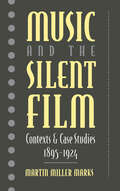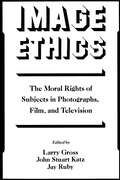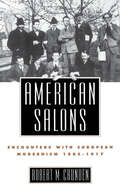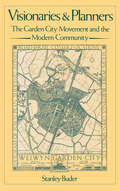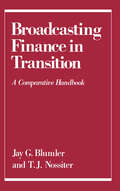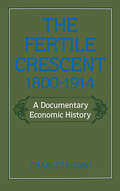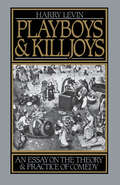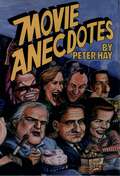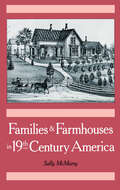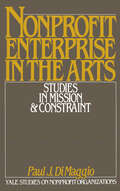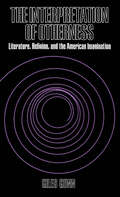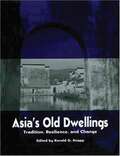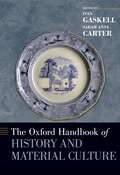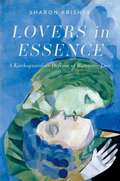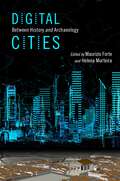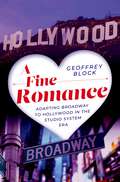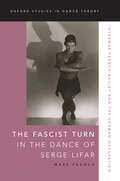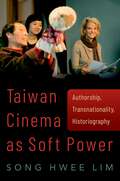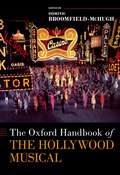- Table View
- List View
Music and the Silent Film: Contexts and Case Studies, 1895-1924
by Martin Miller MarksIn this book, a leading authority on film music examines scores of the silent film era. The first of three projected volumes investigating music written for films, this thoughtful and pathbreaking study demonstrates the richness of silent film music as it details the way in which scores were often planned from the start as an integral part of the whole cinematic experience. Following an introductory chapter that outlines several key theoretical questions and surveys eight decades of writing on film music, Martin Miller Marks focuses on those scores created between 1895 and 1924. He begins by considering two early examples, one German (written by persons unknown for Skladanowsky's Bioskop exhibitions in 1895 and 1896) and one French (scored by Camille Saint-Saëns for the 1908 film L'Assassinat du Duc de Guise). Subsequent chapters fully discuss Walter Cleveland Simon's music for the American film An Arabian Tragedy (1912) as well as the Joseph Breil accompaniment to D. W. Griffith's Birth of a Nation (1915). As described in this book, Breil's memorable score--though a compilation derived from many sources--was played by an orchestra as Griffith's sweeping images filled the screen, thus contributing significantly to the great film's success while also achieving remarkable power in its own right. Marks then concludes with a look at Erik Satie's witty and innovative music for the French film Entr'acte (1924), which was the first film score of consequence by an avant-garde composer. Giving unprecedented attention to a vibrant, important, and oft-neglected facet of twentieth-century music, Music and the Silent Film will interest scholars of film theory, film history, modern music, and modern aesthetics.
Image Ethics: The Moral Rights Of Subjects In Photographs, Film, And Television
by Larry Gross John Stuart Katz Jay RubyImage Ethics: The Moral Rights of Subjects in Photographs, Film, and Television (Communication and Society)
by Larry Gross John Stuart Katz Jay RubyThis pathbreaking collection of thirteen original essays examines the moral rights of the subjects of documentary film, photography, and television. Image makers--photographers and filmmakers--are coming under increasing criticism for presenting images of people that are considered intrusive and embarrassing to the subject. Portraying subjects in a "false light," appropriating their images, and failing to secure "informed consent" are all practices that intensify the debate between advocates of the right to privacy and the public's right to know. Discussing these questions from a variety of perspectives, the authors here explore such issues as informed consent, the "right" of individuals and minority groups to be represented fairly and accurately, the right of individuals to profit from their own image, and the peculiar moral obligations of minorities who image themselves and the producers of autobiographical documentaries. The book includes a series of provocative case studies on: the documentaries of Frederick Wiseman, particularly Titicut Follies; British documentaries of the 1930s; the libel suit of General Westmoreland against CBS News; the film Witness and its portrayal of the Amish; the film The Gods Must be Crazy and its portrayal of the San people of southern Africa; and the treatment of Arabs and gays on television. The first book to explore the moral issues peculiar to the production of visual images, Image Ethics will interest a wide range of general readers and students and specialists in film and television production, photography, communications, media, and the social sciences.
American Salons: Encounters with European Modernism, 1885-1917
by Robert M. CrundenIn American Salons, Robert Crunden provides a sweeping account of the American encounter with European Modernism up to the American entry into World War I. Crunden begins with deft portraits of the figures who were central to the birth of Modernism, including James Whistler, the eccentric expatriate American painter who became the archetypal artist in his dress and behavior, and Henry and William James, who broke new ground in the genre of the novel and in psychology, influencing an international audience in a broad range of fields. At the heart of the book are the American salons--the intimate, personal gatherings of artists and intellectuals where Modernism flourished. In Chicago, Floyd Dell and Margery Currey spread new ideas to Sherwood Anderson, Theodore Dreiser, and others. In London, Ezra Pound could be found behind everything from the cigars of W. B. Yeats to the prose of Ford Madox Hueffer. In Paris, the salons of Leo and Gertrude Stein, and Michael and Sarah Stein, gave Picasso and Matisse their first secure audiences and incomes; meanwhile, Gertrude Stein produced a new writing style that had an incalculable impact on the generation of Ernest Hemingway. Most important of all were the salons of New York City. Alfred Stieglitz pioneered new forms of photography at the famous 291 Gallery. Mabel Dodge brought together modernist playwrights and painters, introducing them to political reformers and radicals. At the salon of Walter and Louise Arensberg, Marcel Duchamp and Francis Picabia rubbed shoulders with Wallace Stevens, Man Ray, and William Carlos Williams. By 1917, no art in America remained untouched by these new institutions. From the journalism of H. L. Mencken to the famous 1913 Armory Show in New York, Crunden illuminates this pivotal era, offering perceptive insights and evocative descriptions of the central personalities of Modernism.
Visionaries and Planners: The Garden City Movement and the Modern Community
by Stanley BuderFor nearly a century the Garden City movement has represented one end of a continuum in an ongoing debate about the future of the modern city. In 1898 Ebenezer Howard envisioned an experimental community as the alternative to huge, teeming cities. Small, planned "garden cities" girdled by greenbelts were to serve in time as the "master key" to a higher, more cooperative stage of civilization based on ecologically balanced communities. Howard soon founded an international planning movement which ever since has represented a remarkable blend of accommodation to and protest against urban changes and the rise of the suburbs. In this interconnected history of the Garden City movement in the United States and Britain, Buder examines its influence, strengths and limitations. Howard's garden city, he shows, joined together two very different types of late-nineteenth-century experimental communities, creating a tension never fully resolved. One approach, utopian and radical in nature, challenged conventional values; the other, the model industrial towns of "enlightened" capitalists, reinforceed them. Buder traces this tension through planning history from the nineteenth-century world of visionaries, philanthropy, and self help into our own with its reliance on the expert, bureaucracy, and governmental policy, shedding light on the complex changes in the way we have thought in the twentieth century about community, urban design, and indeed the process of change. His final chapters examine the world-wide enthusiasm for "New Towns" between 1945-1975 and recent political and social trends which challenge many fundamental assumptions of modern planning.
Broadcasting Finance In Transition: A Comparative Handbook
by Jay G. Blumler T. J. NossiterThis is an important study of the crucial issue of alternatives in commercial and public support of broadcasting in the U.S. and Europe. The Peacock Committee on Financing the BBC, a committee sponsored by the British government, commissioned Jay Blumler and Tom Nossiter to investigate the impact of alternate ways of financing the BBC on the range and quality of broadcasting. They then commissioned papers on broadcasting financing in the United States, Canada, the Netherlands, France, Italy, Sweden, Germany, Australia, New Zealand, and Japan to answer the question: "Should the BBC allow some commercial support in financing?" This is an essential collection for broadcast policy-makers and researchers.
The Fertile Crescent, 1800-1914: A Documentary Economic History (Studies in Middle Eastern History)
by Charles IssawiThis is the first comprehensive history and economic analysis of the Fertile Crescent during the 19th century, a region currently encompassing Iraq, Syria, Lebanon, Israel, Jordan, and a small part of Turkey. Presenting 155 carefully selected documents--the majority drawn from British and French archives and here published for the first time, the balance translated from Arabic, French, German, Russian, Hebrew, Italian, and Turkish sources--Issawi provides an in-depth treatment of the economic life of the region, with chapters on social life and organization, trade, transport, agriculture, industry, and public and private finance. Including extensive cross-references that pinpoint the connections between the subjects discussed, the book is an invaluable resource on a historically rich and dynamic region.
Playboys and Killjoys: An Essay on the Theory and Practice of Comedy
by Harry LevinHarry Levin--one of America's major literary critics--offers a brilliant and original study of the whole world of comedy, concentrating on playwrights through the centuries, from Aristophanes and Plautus in classical times to Bernard Shaw and Bertolt Brecht and their recent successors. Viewing the comic repertory as a richly varied yet broadly unified whole, Levin provides a synthesis of theories and practice. Isolating two fundamental aspects of comedy--the ludicrous and irreverent "playboy," whom we laugh with, and the ridiculous and forbidding "killjoy," whom we laugh at--he traces the dialectical interplay of these components throughout history and across various cultures and media. While mainly focusing on the plays and the stage, with discussions of such major dramatists as Shakespeare, Ben Jonson, Molière, and William Congreve, Levin also includes essays on such related topics as humor, satire, and games.
Movie Anecdotes
by Peter HayHollywood, Walter Winchell quipped, is where they shoot too many movies and not enough actors. Always looking for an angle, always, scheming, always the scene of clashing egos, the movie industry is where they place you under contract instead of observation--and if you don't have anything nice to say, write it down. "In 1940, I had my choice between Hitler and Hollywood," French director René Clair recalled, "and I preferred Hollywood--just a little." In Movie Anecdotes, Peter Hay treats us to a delightful ride through the world that has captivated audiences for almost a century, with stories that are often hilarious, sometimes tragic, and always entertaining. He takes us from the rough-and tumble early days (when one studio paid Pancho Villa $25,000 to launch his attacks only in daylight, after a film crew had set up) to the studio era (when Joan Crawford refused to cross the street on the MGM lot except in a chauffeured limousine) to the shenanigans of today's global industry. Here are stories about all the legends: Charlie Chaplin, Greta Garbo, John Barrymore, Mae West, Lucille Ball, Marilyn Monroe, Errol Flynn, Humphrey Bogart, Bette Davis, Judy Garland, Sophia Loren, John Wayne, and, of course, Ronald Reagan. There are the great directors from D.W. Griffith, Hitchcock, and Eisenstein, to Kurosawa, Bergman, Visconti, Huston, Ford, and Woody Allen. And Hay has selected tales of the writers, the wits, and the grand moguls, including perhaps the largest collection of Goldwynisms--both genuine and apocryphal. Along with the laughter, this volume recreates the conflicts that have torn the movie world, from battles over money and contracts, to discrimination, divorces, and scandals. Colorful, incredible, bitter, funny--the stories about moviemaking are as fantastic as the pictures themselves. Now they have been gathered together in an irresistible bouquet that is certain to delight every movie buff and provide fascinating insights for serious students of film.
Families and Farmhouses in Nineteenth-Century America: Vernacular Design and Social Change
by Sally McMurryThe antebellum era and the close of the 19th century frame a period of great agricultural expansion. During this time, farmhouse plans designed by rural men and women regularly appeared in the flourishing Northern farm journals. This book analyzes these vital indicators of the work patterns, social interactions, and cultural values of the farm families of the time. Examining several hundred owner-designed plans, McMurry shows the ingenious ways in which "progressive" rural Americans designed farmhouses in keeping with their visions of a dynamic, reformed rural culture. From designs for efficient work spaces to a concern for self-contained rooms for adolescent children, this fascinating story of the evolution of progressive farmers' homes sheds new light on rural America's efforts to adapt to major changes brought by industrialization, urbanization, the consolidation of capitalist agriculture, and the rise of the consumer society.
Nonprofit Enterprise In The Arts: Studies In Mission And Constraint
by Paul J. DiMaggioTaking the dichotomy of nonprofit "high culture" and for-profit "popular culture" into consideration, this volume assesses the relationship between social purpose in the arts and industrial organization. DiMaggio brings together some of the best works in several disciplines that focus on the significance of the nonprofit form for our cultural industries, the ways in which nonprofit arts organizations are financed, and the constraints that patterns of funding place on the missions that artists and trustees may wish to pursue. Showing how the production and distribution of art are organized in the United States, the book delineates the differing roles of nonprofit organizations, proprietary firms, and government agencies. In doing so, it brings to the surface some of the special tensions that beset arts management and policy, the way the arts are changing or are likely to change, and the policy alternatives "high culture" faces.
The Interpretation of Otherness: Literature, Religion, and the American Imagination
by Giles GunnIn a unique and probing analysis, this study examines the function of literary criticism in religious studies and explores the relation of literature to religion in the works of major American writers.
Asia's Old Dwellings: Architectural Tradition And Change (Asian Cultural Heritage Ser.)
by Ronald G. KnappThe Oxford Handbook of History and Material Culture (Oxford Handbooks)
Most historians rely principally on written sources. Yet there are other traces of the past available to historians: the material things that people have chosen, made, and used. This book examines how material culture can enhance historians' understanding of the past, both worldwide and across time. The successful use of material culture in history depends on treating material things of many kinds not as illustrations, but as primary evidence. Each kind of material thing-and there are many-requires the application of interpretive skills appropriate to it. These skills overlap with those acquired by scholars in disciplines that may abut history but are often relatively unfamiliar to historians, including anthropology, archaeology, and art history. Creative historians can adapt and apply the same skills they honed while studying more traditional text-based documents even as they borrow methods from these fields. They can think through familiar historical problems in new ways. They can also deploy material culture to discover the pasts of constituencies who have left few or no traces in written records. The authors of this volume contribute case studies arranged thematically in six sections that respectively address the relationship of history and material culture to cognition, technology, the symbolic, social distinction, and memory. They range across time and space, from Paleolithic to Punk.
The Oxford Handbook of History and Material Culture (Oxford Handbooks)
by Ivan Gaskell Sarah Anne CarterMost historians rely principally on written sources. Yet there are other traces of the past available to historians: the material things that people have chosen, made, and used. This book examines how material culture can enhance historians' understanding of the past, both worldwide and across time. The successful use of material culture in history depends on treating material things of many kinds not as illustrations, but as primary evidence. Each kind of material thing-and there are many-requires the application of interpretive skills appropriate to it. These skills overlap with those acquired by scholars in disciplines that may abut history but are often relatively unfamiliar to historians, including anthropology, archaeology, and art history. Creative historians can adapt and apply the same skills they honed while studying more traditional text-based documents even as they borrow methods from these fields. They can think through familiar historical problems in new ways. They can also deploy material culture to discover the pasts of constituencies who have left few or no traces in written records. The authors of this volume contribute case studies arranged thematically in six sections that respectively address the relationship of history and material culture to cognition, technology, the symbolic, social distinction, and memory. They range across time and space, from Paleolithic to Punk.
Lovers in Essence: A Kierkegaardian Defense of Romantic Love
by Sharon KrishekRomantic love is a defining phenomenon in human existence, and an object of heightened interest for literature, art, popular culture, and psychology. But what is romantic love and why is it typically experienced as so central? Sharon Krishek's primary aim in this work is to explore the nature of romantic love through the philosophy of Søren Kierkegaard, and in doing so, to defend it as a moral phenomenon. She does so by developing a connection between love and selfhood, here explained in terms of one's distinct individuality. To be a self, she claims, is to possess a "name," that is, an individual essence. It is when we love that we regard people by their names; we respond to who they truly are. Therefore, love is a correspondence between essences: if Jane Eyre loves Edward Rochester, she responds to him being "who he is," by virtue of her being "who she is." The conception of being thus correspondent has important implications as to the moral and spiritual value of romantic love. Relying on Kierkegaard's analysis of the self, of faith, and of love--even if sometimes in a way that departs from Kierkegaard's explicit position--Krishek explores these implications, construing romantic love as a desirable phenomenon, emotionally, morally, and spiritually.
Lovers in Essence: A Kierkegaardian Defense of Romantic Love
by Sharon KrishekRomantic love is a defining phenomenon in human existence, and an object of heightened interest for literature, art, popular culture, and psychology. But what is romantic love and why is it typically experienced as so central? Sharon Krishek's primary aim in this work is to explore the nature of romantic love through the philosophy of Søren Kierkegaard, and in doing so, to defend it as a moral phenomenon. She does so by developing a connection between love and selfhood, here explained in terms of one's distinct individuality. To be a self, she claims, is to possess a "name," that is, an individual essence. It is when we love that we regard people by their names; we respond to who they truly are. Therefore, love is a correspondence between essences: if Jane Eyre loves Edward Rochester, she responds to him being "who he is," by virtue of her being "who she is." The conception of being thus correspondent has important implications as to the moral and spiritual value of romantic love. Relying on Kierkegaard's analysis of the self, of faith, and of love--even if sometimes in a way that departs from Kierkegaard's explicit position--Krishek explores these implications, construing romantic love as a desirable phenomenon, emotionally, morally, and spiritually.
Digital Cities: Between History and Archaeology
by Maurizio Forte and Helena MurteiraThe onset of digital archaeology and its subsequent remarkable development has had a crucial impact on the study of cultural heritage. Presently, researchers are able to manipulate and reinvent digital and historical data; the study of the city stands out in this context. Cities are microcosms, often reflecting the changing structure of societies over time. A vast array of digital tools (laser scanning, augmented reality, remote sensing, and beyond) can process, test, and display archaeological data, architectural remains, and built heritage on a scale previously unattainable. The digitization of historical research is manipulating and reinventing the ways in which we examine historical evidence. This intersection between history and computer science allows for an expansion and enhancement of historical, archaeological, and anthropological research. The resulting configurations lead to the creation of new data and new objects of study within these fields, which makes it crucial for those in these fields to understand the impact of generating digital information in this context. Digital Cities explores the study of the city in the digital realm by reexamining the data processing and knowledge sharing between historians, architects, geographers, anthropologist, and computer scientists. Digital Cities considers the city from pre-historic settlements to the present in different geographical contexts. Each section of the book offers a new level of engagement with various digital tools, spanning topics such as the challenges digital instruments pose to the study of pre-urban and urban contexts, the didactic scope of virtual heritage, and the consolidation of the relationship between digital language and historical narrative. The resulting research traverses the idea of Digital Cities through a historical, social, and multimodal context, and it fills the gap in scholarship between the study of the city and the concept and significance of the Digital City.
A Fine Romance: Adapting Broadway to Hollywood in the Studio System Era
by Geoffrey BlockHow do we compare a Broadway musical to its Hollywood counterpart? A Fine Romance: Adapting Broadway to Hollywood in the Studio System Era answers this question by exploring the symbiotic relationship between a dozen Broadway musicals and their Hollywood film adaptations. From enduring classics like Oklahoma!, Brigadoon, and West Side Story to lesser-known gems such as Cabin in the Sky, Call Me Madam, and Silk Stockings, author Geoffrey Block examines some of the best loved stage and screen musicals of all time as well as neglected works that deserve our attention and respect. Block delves into what happens during the transfer of stories from stage to film, the critical criteria that motivates decisions to alter or preserve stage elements when adapting to film, and the dramatic and musical consequences at play in these artistic and commercial choices. In telling this story, A Fine Romance engages with aesthetic and critical concerns while also considering the social issues around Broadway and Hollywood film through the lenses of race and ethnicity, class, gender, and sexual identity. Beginning with the stage debut of Show Boat in 1927 and concluding with the release of Bob Fosse's cinematic re-envisioning of Cabaret nearly a half century later in 1972, the romance between Broadway and Hollywood was frequently turbulent. Differing commercial and aesthetic models and goals of Broadway and Hollywood created both conflicting and harmonious collaborations. Attempts at economic and artistic domination, irreconcilable differences, and occasional broken promises ensued. At other times, the screen and stage creative teams aligned, resulting in well-crafted, much admired, and frequently breathtaking films.
A Fine Romance: Adapting Broadway to Hollywood in the Studio System Era
by Geoffrey BlockHow do we compare a Broadway musical to its Hollywood counterpart? A Fine Romance: Adapting Broadway to Hollywood in the Studio System Era answers this question by exploring the symbiotic relationship between a dozen Broadway musicals and their Hollywood film adaptations. From enduring classics like Oklahoma!, Brigadoon, and West Side Story to lesser-known gems such as Cabin in the Sky, Call Me Madam, and Silk Stockings, author Geoffrey Block examines some of the best loved stage and screen musicals of all time as well as neglected works that deserve our attention and respect. Block delves into what happens during the transfer of stories from stage to film, the critical criteria that motivates decisions to alter or preserve stage elements when adapting to film, and the dramatic and musical consequences at play in these artistic and commercial choices. In telling this story, A Fine Romance engages with aesthetic and critical concerns while also considering the social issues around Broadway and Hollywood film through the lenses of race and ethnicity, class, gender, and sexual identity. Beginning with the stage debut of Show Boat in 1927 and concluding with the release of Bob Fosse's cinematic re-envisioning of Cabaret nearly a half century later in 1972, the romance between Broadway and Hollywood was frequently turbulent. Differing commercial and aesthetic models and goals of Broadway and Hollywood created both conflicting and harmonious collaborations. Attempts at economic and artistic domination, irreconcilable differences, and occasional broken promises ensued. At other times, the screen and stage creative teams aligned, resulting in well-crafted, much admired, and frequently breathtaking films.
The Fascist Turn in the Dance of Serge Lifar: Interwar French Ballet and the German Occupation (Oxford Studies in Dance Theory)
by Mark FrankoUkrainian dancer and choreographer Serge Lifar (1905-86) is recognized both as the modernizer of French ballet in the twentieth century and as the keeper of the flame of the classical tradition upon which the glory of French ballet was founded. Having migrated to France from Russia in 1923 to join Diaghilev's Ballets Russes, Lifar was appointed star dancer and ballet director at the Paris Opéra in 1930. Despite being rather unpopular with the French press at the start of his appointment, Lifar came to dominate the Parisian dance scene-through his publications as well as his dancing and choreography-until the end of the Second World War, reaching the height of his fame under the German occupation of Paris (1940-44). Rumors of his collaborationism having remained inconclusive throughout the postwar era, Lifar retired in 1958. This book not only reassesses Lifar's career, both aesthetically and politically, but also provides a broader reevaluation of the situation of dance-specifically balletic neoclassicism-in the first half of the twentieth century. The Fascist Turn in the Dance of Serge Lifar is the first book not only to discuss the resistance to Lifar in the French press at the start of his much-mythologized career, but also the first to present substantial evidence of Lifar's collaborationism and relate it to his artistic profile during the preceding decade. In examining the political significance of the critical discussion of Lifar's body and technique, author Mark Franko provides the ground upon which to understand the narcissistic and heroic images of Lifar in the 1930s as prefiguring the role he would play in the occupation. Through extensive archival research into unpublished documents of the era, police reports, the transcript of his postwar trial and rarely cited newspaper columns Lifar wrote, Franko reconstructs the dancer's political activities, political convictions, and political ambitions during the Occupation.
FASC TURN IN DANCE OF SERGE LIFAR OSDT C: Interwar French Ballet and the German Occupation (Oxford Studies in Dance Theory)
by Mark FrankoUkrainian dancer and choreographer Serge Lifar (1905-86) is recognized both as the modernizer of French ballet in the twentieth century and as the keeper of the flame of the classical tradition upon which the glory of French ballet was founded. Having migrated to France from Russia in 1923 to join Diaghilev's Ballets Russes, Lifar was appointed star dancer and ballet director at the Paris Opéra in 1930. Despite being rather unpopular with the French press at the start of his appointment, Lifar came to dominate the Parisian dance scene-through his publications as well as his dancing and choreography-until the end of the Second World War, reaching the height of his fame under the German occupation of Paris (1940-44). Rumors of his collaborationism having remained inconclusive throughout the postwar era, Lifar retired in 1958. This book not only reassesses Lifar's career, both aesthetically and politically, but also provides a broader reevaluation of the situation of dance-specifically balletic neoclassicism-in the first half of the twentieth century. The Fascist Turn in the Dance of Serge Lifar is the first book not only to discuss the resistance to Lifar in the French press at the start of his much-mythologized career, but also the first to present substantial evidence of Lifar's collaborationism and relate it to his artistic profile during the preceding decade. In examining the political significance of the critical discussion of Lifar's body and technique, author Mark Franko provides the ground upon which to understand the narcissistic and heroic images of Lifar in the 1930s as prefiguring the role he would play in the occupation. Through extensive archival research into unpublished documents of the era, police reports, the transcript of his postwar trial and rarely cited newspaper columns Lifar wrote, Franko reconstructs the dancer's political activities, political convictions, and political ambitions during the Occupation.
Taiwan Cinema as Soft Power: Authorship, Transnationality, Historiography
by Song Hwee LimWhy has Taiwanese film been so appealing to film directors, critics, and audiences across the world? This book argues that because Taiwan is a nation without hard political and economic power, cinema becomes a form of soft power tool that Taiwan uses to attract global attention, to gain support, and to build allies. Author Song Hwee Lim shows how this goal has been achieved by Taiwanese directors whose films win the hearts and minds of foreign audiences to make Taiwan a major force in world cinema. The book maps Taiwan's cinematic output in the twenty-first century through the three keywords in the book's subtitle-authorship, transnationality, historiography. Its object of analysis is the legacy of Taiwan New Cinema, a movement that begun in the early 1980s that has had a lasting impact upon filmmakers and cinephiles worldwide for nearly forty years. By examining case studies that include Hou Hsiao-hsien, Ang Lee, and Tsai Ming-liang, this book suggests that authorship is central to Taiwan cinema's ability to transcend borders to the extent that the historiographical writing of Taiwan cinema has to be reimagined. It also looks at the scaling down of soft power from the global to the regional via a cultural imaginary called "little freshness", which describes films and cultural products from Taiwan that have become hugely popular in China and Hong Kong. In presenting Taiwan cinema's significance as a case of a small nation with enormous soft power, this book hopes to recast the terms and stakes of both cinema studies and soft power studies in academia.
Taiwan Cinema as Soft Power: Authorship, Transnationality, Historiography
by Song Hwee LimWhy has Taiwanese film been so appealing to film directors, critics, and audiences across the world? This book argues that because Taiwan is a nation without hard political and economic power, cinema becomes a form of soft power tool that Taiwan uses to attract global attention, to gain support, and to build allies. Author Song Hwee Lim shows how this goal has been achieved by Taiwanese directors whose films win the hearts and minds of foreign audiences to make Taiwan a major force in world cinema. The book maps Taiwan's cinematic output in the twenty-first century through the three keywords in the book's subtitle-authorship, transnationality, historiography. Its object of analysis is the legacy of Taiwan New Cinema, a movement that begun in the early 1980s that has had a lasting impact upon filmmakers and cinephiles worldwide for nearly forty years. By examining case studies that include Hou Hsiao-hsien, Ang Lee, and Tsai Ming-liang, this book suggests that authorship is central to Taiwan cinema's ability to transcend borders to the extent that the historiographical writing of Taiwan cinema has to be reimagined. It also looks at the scaling down of soft power from the global to the regional via a cultural imaginary called "little freshness", which describes films and cultural products from Taiwan that have become hugely popular in China and Hong Kong. In presenting Taiwan cinema's significance as a case of a small nation with enormous soft power, this book hopes to recast the terms and stakes of both cinema studies and soft power studies in academia.
The Oxford Handbook of the Hollywood Musical (OXFORD HANDBOOKS SERIES)
Since the release of Baz Luhrmann's Moulin Rouge! in 2001, the film musical has returned to popularity as one of the most important cinematic genres, with box office hits that appeal to audiences of all ages. Yet the history of the musical on film goes back over seven decades earlier, stretching from early examples like The Jazz Singer (1927), the first ever film with synchronized sound, through the Astaire-Rogers musicals of the 1930s, the MGM and Warner Brothers extravaganzas of the 1940s and '50s, and the roadshow era of the 1960s. The genre's renaissance with La La Land (2016) and The Greatest Showman (2017) proves that it remains as appealing as ever, capable of both high critical acclaim and widespread box office success. The Oxford Handbook of the Hollywood Musical, curated by editor Dominic Broomfield-McHugh, reflects and expands on current scholarship on the film musical in a handbook that mixes new discoveries through archival research with new perspectives on familiar titles. It addresses issues such as why audiences accept people bursting into song in musicals; how technology affects the way numbers are staged; and how writers have adapted their material to suit certain stars. It also looks at critical issues such as racism and sexism, and assesses the role and nature of the film musical in the twenty-first century. A remarkable survey at the cutting edge of the field, The Oxford Handbook of the Hollywood Musical will be a resource for students and scholars alike for years to come.
